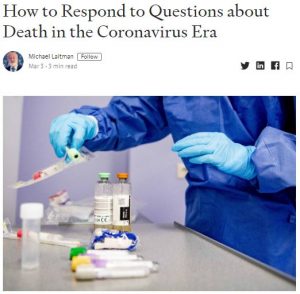
As the Coronavirus continues its world tour, and panic penetrates populations of people, some are facing the ultimate question about death.
How should we respond to death? What is death? What happens after we die?
The nature surrounding us is wise and great. We are birthed within, and develop in, nature. Many systems function on a moment-by-moment basis to sustain our bodies for 70, 80, and even 100-plus years.
But why? Are we supposed to just be born, live then die?
We endure difficult and painful years between our births and deaths. How much pleasure do we actually squeeze out of them? We care for our bodies in a Sisyphean way, and we feel less and less energy to keep going.
It is as if we’re shifting from living-and-breathing organisms into a biodegradable stage, after which we completely disintegrate.
Is there any benefit to such an existence? Or are we just supposed to struggle for years to make our way in life as best as we can until we eventually perish?
Evaluating the Purpose of Life through Four Levels of Nature
Each and every finest detail of nature holds benefit and continuity.
There are three distinct levels in nature: still, vegetative and animate. The person, in his current developmental stage, belongs to the animate world. Humanity, however, differentiates itself as the “speaking” level, which is higher than the animate.
What, then, makes humans different to animals?
We are fundamentally a two-legged breathing mammal that fulfills its basic animal needs to eat, drink, sleep and reproduce. However, we have additional mental and emotional capacity, letting us absorb knowledge and wisdom. We raise children, pass knowledge from one generation to the next, and develop tools and our society with the aim of making us feel better and more comfortable.
In other words, we have basic survival needs for food, shelter, sex and family, and then we have social needs where we compare ourselves to others, and we thus fence ourselves off from each other, clothing ourselves, housing ourselves and filling our houses and bodies with countless products that we advertise to each other.
So are we just “smart animals” that have worked out how to make ourselves more comfortable in the world?
The Key Difference between Humans and Animals
The key difference between humans and animals is that we humans have a deeper aspiration seeded within us that aspires beyond the boundaries of our temporary protein bodies.
We also have the ability to pinpoint this aspiration. Like animals, we’re afraid of death and want to live. But in addition to animals, only we humans ask about why we live.
Not all humans ask about the meaning of life. Around a tenth of the adult population asks about the meaning of life, and all children ask about it, but soon forget.
Therefore, the coronavirus, conflicts between different countries and factions, falls of markets, and fierce social division: the harm that society’s cells do to themselves spread like a disease throughout the body of humanity.
And part and parcel with our global-scale problems is a global awakening of life’s deeper questions.
The Journey to the Ultimate Sensation of Our Common Origin
I hope that people with such questions will seek their answers, disallowing the billions of materialistic influences to distract our journey to the sublime perception and sensation of our common origin, and learning and implementing the laws of that perfect reality on the way.
By actively seeking to uncover the answers to our inquiries, like peeling layers of an onion, we delve deeper into the understanding of the need to connect positively to others. Through our positive connection, we enter reality’s control room, balancing our attitude with nature’s attitude of mutual love and bestowal in an interconnected and interdependent wholeness.
When we reach such equivalence of form with nature, we become healthy and beneficial parts in the system of our existence, entering into direct contact with nature’s fundamental quality — love and bestowal — and experiencing a new and perfect life, free of fears, mistakes and problems.
Featured in Medium